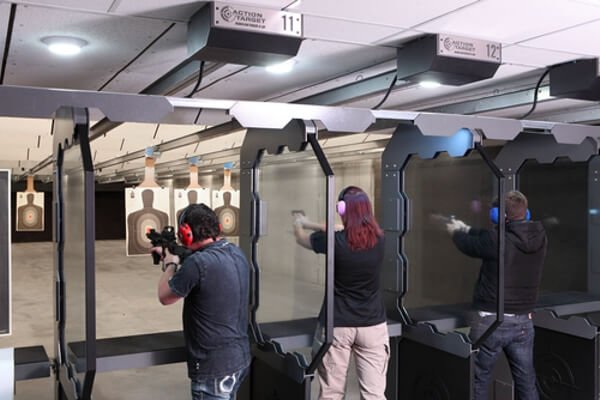The correct use Personal Protective Equipment (PPE) at gun ranges is designed to help shooters combat the potentially adverse environment of an active shooting range. Loud noises from bullets firing and hot ejected casings bouncing off tables, walls, and stall dividers are some of the hazards found of the local gun range. The use of PPE at your local gun range is meant to compliment the engineering controls already in place, such as a properly designed ventilation system, concrete walls and floors meeting a minimum thickness, steel or cinder block dividers between shooters designed to resist sideways bullet penetration, ballastic resistant glass, doors, and ceilings, and other construction design elements that are part of the gun range. The mandatory use of PPE is also an extension of administrative controls, such as familiarity and consent to follow gun safety rules, safety videos, safety instruction, and the enforcement of these administrative controls by a range safety officer. PPE adds one more layer of customer protection ensuring a positive shooting experience.
Although management requires that all shooters wear PPE before entering the shooting area, it is the customer’s ultimate responsibility to follow all the range rules – especially rules concerning PPE – both before and during their presence on the shooting line. Administration has identified various potential hazards on the shooting line and has crafted rules designed to reduce staff and customer exposure to harm. Part of this goodwill collaborative relationship between management and customer requires that those in the shooting area do their part for the sake of personal safety and actually wear PPE throughout their shooting experience. While PPE might differ from range to range, e.g., an outdoor range might require that customers wear reflective safety vests whereas an indoor range might not have this requirement, most ranges share the requirement for eye protection and hearing protection.
Family Armory range rules state:
Personal protective equipment (PPE) must be worn at all times in the shooting area. Minimum PPE includes BOTH eye protection AND hearing protection. NOTE: Spent rounds are extremely hot. Exposed skin from tank-tops, muscle shirts, sandals, and low-cut shirts increase burn risk. Dress for safety.
PERSONAL PROTECTIVE EQUIPMENT
Shooters must adorn eye protection while on the shooting line.
Semi-automatic pistols and rifles eject bullet casings after each shot; these ammunition casings are hot and light weight and tend to bounce off nearby walls, stall dividers, and tables. Because no one can predict what a bullet casing might hit on its way down, wearing safety glasses the entire time while shooting is always a good idea. Wearing safety glasses is especially important when more shooters are present because more shooters mean that there will be more casings, and no one wants to experience a hot bullet casing in the eye.
Shooters must dress for safety.
PPE also refers to the clothes and apparel customers wear to the shooting range. You see, hot bullet casings are indiscriminate and unpredictable when it comes to the place where they finally land. And it has happened on more than one occasion at more than one gun range that a casing has landed in a customer’s clothing. In those situations, the unexpected shock of a hot ammunition casing against their skin activated the customer’s sudden reflex to remove the source of the pain as quickly as possible. This reflexive jerk movement might take place at same time that a loaded firearm was in the customer’s hand – escalating the chance of an accidental discharge with the muzzle pointing in an unintentional direction. PPE can prevent hot casings from going places on the body that they are not supposed to go.
Shooters must use hearing protection.
“Exposure to noise greater than 140 dB can permanently damage hearing. Almost all firearms create noise that is over the 140-dB level. A small .22-caliber rifle can produce noise around 140 dB, while big-bore rifles and pistols can produce sound over 175 dB. Firing guns in a place where sounds can reverberate, or bounce off walls and other structures, can make noises louder and increase the risk of hearing loss. Also, adding muzzle brakes or other modifications can make the firearm louder. People who do not wear hearing protection while shooting can suffer a severe hearing loss with as little as one shot, if the conditions are right. Audiologists see this often, especially during hunting season when hunters and bystanders may be exposed to rapid fire from big-bore rifles, shotguns, or pistols.” – American Speech Language Association
Summary: Gun ranges require all on the shooting line to wear Personal Protective Equipment (PPE), such as ear protection and eye protection. PPE is an administrative safety control designed to reduce or eliminate customer exposure to loud noise and ejected casings.






